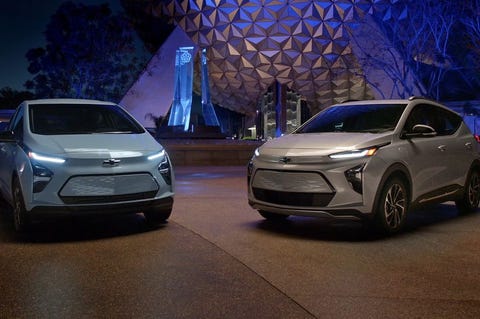This Week in Cars: The Porsche 911 GT3, the Chevy Bolt EUV, the Chip Shortage
British Uber drivers are entitled to rest breaks, paid time off on holidays, and a minimum wage after Britain’s Supreme Court unanimously dismissed Uber’s challenge to a lower court decision. Never in a rush to adopt fair labor practices, Uber says the decision only applies to a limited number of drivers who worked with the company in 2016.
This Week in Sheetmetal
Porsche has gifted us with the next generation of 911 GT3, which will have a new suspension setup and a 502-hp 4.0-liter naturally aspirated flat-six engine that revs to 9000 rpm. Long may it reign.
Chevy showed not one but two new Bolts this week. One is a redesign of the hatchback we’ve come to know and like, the other an EUV (yes, that’s electric utility vehicle) that shares a platform and powertrain with the smaller Bolt but offers more space and GM’s self-driving suite at a negligible range penalty.
Maserati has a BMW X3 fighter in the works in the form of the 2022 Grecale. Details are scarce, but we know it will share a significant number of components with the Alfa Romeo Stelvio, and we’re hoping there will be a high-performance V-8-powered Trofeo model, too.
McLaren showed its first plug-in hybrid, the Artura, which is powered by a new 577-hp V-6 engine but can travel on battery power alone for an estimated 19 miles (based on the European test cycle). The Artura’s platform is meant to eventually accommodate a fully electric powertrain. Most importantly, it looks like a McLaren ought to. Which is to say, pretty wild.
The Best-Laid Plans
Jaguar announced it will go all-electric by 2025 and also that it has scrapped plans for an electric XJ sedan even though that car had already spent years in development and was nearly ready for market. CEO Thierry Bolloré wouldn’t promise that Jag will continue offering sports cars after its transition to EVs.
Mercedes-Benz’s already delayed EQC, which we once expected to be the first Mercedes EV to make it stateside (we’re not counting the Smart Fortwo and neither should you), has been canceled for the U.S. market. The EQC will still go on sale in Europe, and we expect the EQ brand, which will be home to all of Mercedes’ EVs, to make its U.S. debut this fall with the S-class-based EQS.
Playing Favorites
If you thought you’d heard the last of the global microchip shortage, think again. In the fallout from the winter storm that hobbled Texas’s energy grid, the city of Austin asked two local Samsung plants that manufacture semiconductors to shut down production to conserve energy. NXP Semiconductors and Infineon also manufacture chips in Austin, and both companies have limited production at those facilities. Even companies without manufacturing constraints are choosing to supply other customers before automakers.
The chips that most cars use are relatively simple and low profit compared to the ones in, say, an iPhone. And chip makers that were jilted by automakers when demand for new cars cratered last spring are unwilling to invest in new capacity to fulfill orders they say are unreliable. A group of business organizations, including some that represent the auto industry, are lobbying the Biden administration for federal subsidies to support domestic microchip manufacturing, but new plants would take time to come online. IHS Markit now expects the production of a million vehicles to be impacted by the shortage just in the first quarter of this year.
Expert Advice
Speaking of winter weather, it has come to our attention that there are perhaps millions of American drivers who are being exposed to the perils of driving in the snow for the first time. Most members of the Car and Driver staff have a lifetime of experience in snow driving, so if you’re in need of some tips look no further than our guides to winter driving and protecting your car from damage due to extreme cold. If reading two more articles sounds like too much, here’s our number one expert tip on not ending up in a snowy ditch: go slow.
Further Reading
A (not yet peer-reviewed) study from the University of California, Davis, has found that EV owners drive a lot less than their peers with conventional cars, traveling an average of 5300 miles a year or less than half the U.S. average. The study also found that EVs charging increased a household’s energy use by less than half the previously estimated amount.
Or if you’ve already spent more time than you’d like to thinking about EVs, watch this drag race between a Dodge Demon and a Porsche 911 Turbo S instead.
And since we almost got to the end without mentioning Tesla, take a look at this Wall Street Journal analysis of how the company went from billionaire pet project to the S&P 500.
This content is created and maintained by a third party, and imported onto this page to help users provide their email addresses. You may be able to find more information about this and similar content at piano.io


